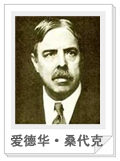爱德华·桑代克(Edward Lee Thorndike)
——心理学家、实验动物心理学创始人(1874―1949) |
|
爱德华·桑代克——生于美国麻省一位牧师家庭,他生性害羞、孤独,只有在学习中才能找到乐趣,也特别有学习的天赋。桑代克在韦斯里扬大学攻读文学学士学位,后来在哈佛大学做詹姆士的学生,在那里,他成为心理学史上第一位用动物来研究学习的人。桑代克未在哈佛大学完成学业,而到了哥伦比亚大学在卡特尔的指导下,继续他的动物研究。1898年发表了博士论文《动物的智慧:动物联结过程中的心理学研究》,同年,桑代克成为哥伦比亚大学师范学院心理学讲师,1903年升任教授。 |
桑代克的研究兴趣十分广泛,他是美国哥伦比亚学派的主要代表,又是动物心理实验的首创者,教育心理学体系和联结主义心理学的创始人,并设计了心理测验,为美国教育测验运动的领袖之一。正因为如此,一些史学家将他划归美国机能主义心理学派,但也有不少人认为他更象行为主义学派的人物,可他本人却认为他并不属于任何一个学派。他一生致力于心理学研究,著述颇多,达507项之多。
桑代克对行为主义学派的影响主要来源于他对小鸡、小猫研究的结果。1895年,他到哈佛大学受教于詹姆斯,做小鸡走迷津实验(即走迷宫),后转到哥伦比亚大学学习,继续利用猫和狗等做实验。他在实验中发现,最初,小鸡小猫小狗都是在死路里转来转去,偶尔会找到出口,逃出迷宫,而这通常需要花很多时间;但重复多次以后,小鸡小猫小狗在死路中转的次数都会减少,花费的时间也会减少很多;训练到一定次数以后,一把它们放入迷宫,它们甚至会立即直奔出口而去,很快就逃脱了。桑代克认为,小鸡小猫小狗都不是通过推理和观察而学会逃出迷宫的;它们之所以能够顺利逃脱,原因只有一点,那就是不断的尝试,在不断的尝试和失败中慢慢消除那些无用的行为,记住那些有助于逃脱的行为,用桑代克的话说,就是它们已经在这些有用的行为和行为的目标之间建立了联系。桑代克进一步提出了他的“联系法”理论,这一理论主要包括两大学习定律:
1.效果律。桑代克认为,哪一种行为会被“记住”,会与刺激建立起联系,取决于这种行为产生的效果。例如,迷宫是一个刺激,小鸡在迷宫中会作出多种行为反应,但大多数反应都不能帮助它们逃出迷宫,而另一些行为则使它们得以逃脱并得到食物。因此,小鸡就记住了这些有效的行为,将迷宫这个刺激和这些有效的行为联系起来了。以后,一进迷宫,它们就知道作出什么反应。
2.练习律。桑代克认为,练习次数的多寡,影响刺激和反应之间练习的稳固程度。练习越多,练习越紧密,小鸡越清楚要采取什么行动,逃脱的速度越快;练习越少,练习就不够紧密,小鸡就越难找到出口。
桑代克的《动物的智慧:动物联结过程中的心理学研究》,被认为是动物实验心理学建立的一个标志,正如冯特在1879年建立心理实验室被认为是实验心理学建立的标志一样。桑代克是教育心理学的创始人,在1903年出版的他的《教育心理学》被公认为是教育心理学诞生的标志。 桑代克的动物实验心理学的建立在心理学家和动物之间架起了一道新的桥梁。他所做的工作并不只是对实验方法的使用,也不能用行为主义的先驱来简单地概括,实际上,桑代克的工作在心理学中开创了一项新的惯例:那就是将动物作为抽象化的工具来介绍人类心理中的一些常见概念。
|
Edward L. Thorndike (1874-1949) |
"The mind is man's connection."
Edward L. Thorndike was born in Williamsburg, MA in 1874. He studied at Wesleyan University and Harvard, and became professor at Teachers College, Columbia (1904-40), where he worked on educational psychology and the psychology of animal learning. He did pioneer work not only in learning theory but also in education practices, verbal behavior, comparative psychology, intelligence testing and the application of quantitative measures to sociopsychological problem. His works include Psychology of Learning (1914) and The Measurement of Intelligence (1926).
Edward L. Thorndike's Theory:
The learning theory of Thorndike represents the original S-R framework of behavioral psychology: Learning is the result of associations forming between stimuli and responses. Such associations or "habits" become strengthened or weakened by the nature and frequency of the S-R pairings. The paradigm for S-R theory was trial and error learning in which certain responses come to dominate others due to rewards. The classic example of Thorndike's S-R theory was a cat learning to escape from a "puzzle box" by pressing a lever inside the box. After much trial and error behavior, the cat learns to associate pressing the lever (S) with opening the door (R). This S-R connection is established because it results in a satisfying state of affairs (escape from the box). The law of exercise specifies that the connection was established because the S-R pairing occurred many times (the law of effect) and was rewarded (law of effect) as well as forming a single sequence (law of readiness). As a result of studying animal intelligence, he formulated his famous "laws of learning".
Law of effect
This law states that the strength of a connection is influenced by the consequences of a response. Before 1930, Thorndike believed that pleasurable consequences strengthened a connection and annoying consequences weakened a connection. After 1930, however, he believed the only pleasurable consequences had an effect on the strength of a connection.
Law of exercise
This law states that the strength of a connection is determined by how often the connection is used. It contains two portions: law of use-the strength of a connection increases when the connection is used; law of disuse-the strength of a connection diminishes when the connection is not used.
Law of readiness
This stated that when an organism is ready to act it's reinforcing for it to do so and annoying for it to do so. Also, when an organism is not ready to act, forcing it to act will be annoying to it.
Spread of effect
Rewards affect not only the connection that produced them but temporally adjacent connections as well. |

 1.效果律。桑代克认为,哪一种行为会被“记住”,会与刺激建立起联系,取决于这种行为产生的效果。例如,迷宫是一个刺激,小鸡在迷宫中会作出多种行为反应,但大多数反应都不能帮助它们逃出迷宫,而另一些行为则使它们得以逃脱并得到食物。因此,小鸡就记住了这些有效的行为,将迷宫这个刺激和这些有效的行为联系起来了。以后,一进迷宫,它们就知道作出什么反应。
1.效果律。桑代克认为,哪一种行为会被“记住”,会与刺激建立起联系,取决于这种行为产生的效果。例如,迷宫是一个刺激,小鸡在迷宫中会作出多种行为反应,但大多数反应都不能帮助它们逃出迷宫,而另一些行为则使它们得以逃脱并得到食物。因此,小鸡就记住了这些有效的行为,将迷宫这个刺激和这些有效的行为联系起来了。以后,一进迷宫,它们就知道作出什么反应。